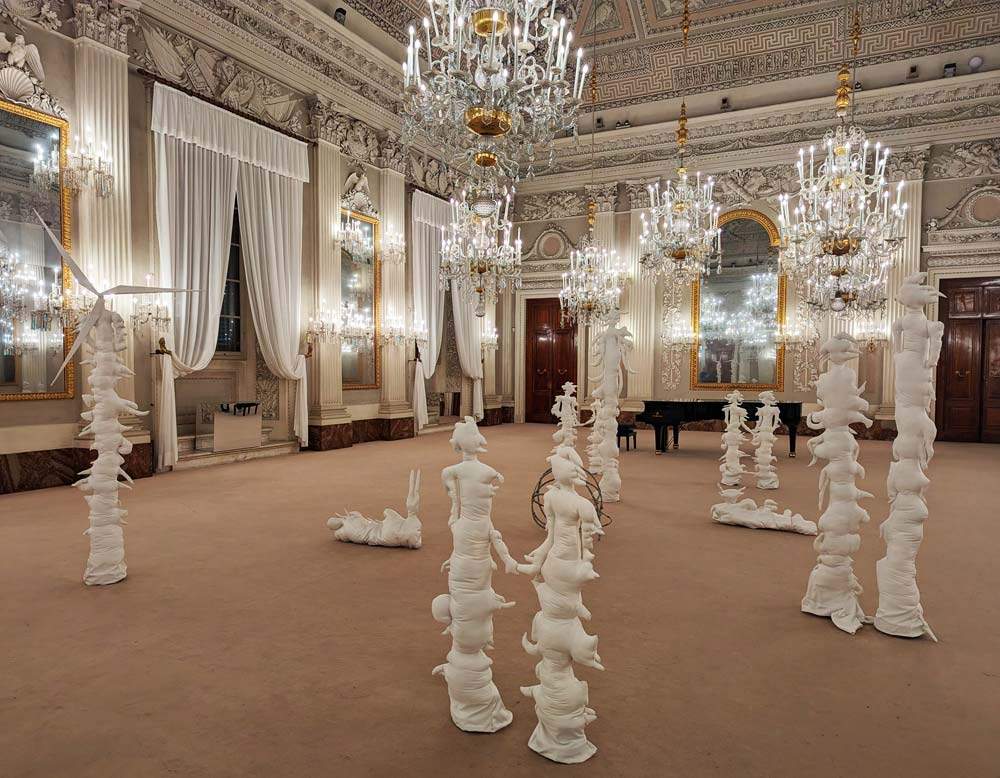Florence, Marya Kazoun's ecological nativity scene installed at Pitti Palace
It is an ecological nativity scene that the Uffizi Galleries is setting up for the holiday season. Indeed, the Sala Bianca in the Pitti Palace has installed the work First Act by Lebanese-Canadian artist Marya Kazoun (Beirut, 1976), which starts with a question: how do we create a new world free of pollution, environmental disasters, and global warming? To answer it, Kazoun offers, until Jan. 29, aninstallation inspired by the nativity scene: its protagonists are the almost tree-like silhouettes of the Magi, made of wadding, 2.60 meters high, and covered in a milky white cloth. They do not bring gifts of gold, frankincense and myrrh but clean energy, represented by the wind blades mounted on top of them.
The wind, which represents the transitory and the elusive, is in this work the vital breath of the universe and those who inhabit it. In opposition to it, the ominous presence of a swarm of locusts, made of Murano glass, symbolizes the climate ruin that is increasingly looming over the fate of the planet. The artist thus associates the ancient biblical disaster with the current ecological disaster to prompt the viewer to reflect and act. The birth of a new world, represented by the spherical sculpture in the center, is admired by six figures arranged in pairs, representing theunion between human beings . Not missing, following the Christian tradition, are the figures of the Virgin Mary and St. Joseph, the ox and the donkey, who watch thoughtfully over the baby Jesus. The metaphysical space of Marya Kazoun’s Nativity, where nightmares, symbols and utopia merge, is inhabited by creatures that open a window to possible futures, from which the viewer can look out to investigate himself and the reality around him.
“Protecting the artistic heritage and preserving the landscape and environmental heritage are serious and urgent duties that should never conflict, but favor each other,” says Uffizi Director Eike Schmidt. “In her installation First Act, Marya Kazoun takes a departure from the nativity tradition and makes us reflect on the gravest danger our planet is facing: that of losing its ecological balance, thus endangering the survival of humankind. The work highlights and exemplifies how natura naturans, inherent in every creative act, necessarily invokes the utmost respect and commitment to creation, while natura naturata in turn shines forth and promotes the miraculous action of natura naturans.”
Adds Marya Kazoun, “Wind whisperers have always inhabited this place, and are an extension of the voices of the past.”
Marya Kazoun, born in Beirut in 1976, is an interdisciplinary artist. She currently lives and works between New York and Venice. Her works are primarily installations and performances, often a combination of both. Most of her works are site-specific and can be expanded and developed over time. Each work has its own narrative and story derived from the artist’s personal journey, childhood memories and cultural background. Kazoun has participated in several solo and group exhibitions internationally. She has participated three times in the Venice Biennale, in 2005, 2009 and 2013 when she was called to represent the city of Venice. Her works have been exhibited at the Pushkin Museum in Moscow, the Museum of Modern Art in Klagenfurt, the Sharjah Biennial (United Arab Emirates), the World Economic Forum in Davos, the PoznaÅ„ Biennial in Poland, the Boca Raton Art Museum in Florida, and the Hermitage in St. Petersburg.
 |
| Florence, Marya Kazoun's ecological nativity scene installed at Pitti Palace |
Warning: the translation into English of the original Italian article was created using automatic tools. We undertake to review all articles, but we do not guarantee the total absence of inaccuracies in the translation due to the program. You can find the original by clicking on the ITA button. If you find any mistake,please contact us.





























